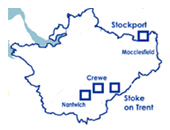Piriformis Syndrome
The piriformis is a muscle that travels behind the hip in the buttock and it aids in external rotation (turning out) of the leg. The piriformis muscle tendon is close to the sciatic nerve going down the back of the leg. The piriformis tendon and sciatic nerve cross each in the buttock. Piriformis syndrome is a disorder that occurs when the piriformis muscle compresses or irritates the sciatic nerve, the largest nerve in the body. This causes pain and tingling or numbness in the buttocks and along the nerve, down the leg. The pain is worse as a result of sitting for a long period of time, particularly driving, climbing stairs, walking, or running.
In some cases, the muscle may be injured due to a fall onto the bottom. Bruising of the piriformis muscle leads to swelling and muscle spasm putting pressure on the sciatic nerve.
Piriformis syndrome commonly causes pain that goes down the back of the leg and can be confused with a slipped disc.
Sitting may be uncomfortable with relief only coming from lifting the affected buttock off the seat. This can make driving distances a problem..
Diagnosis and Treatment
Your Osteopath will take a careful case history and then examine you in great detail, noting your ranges and quality of movement. He will do minor tests for trapped nerves and in rare cases may request an MRI scan.
When a diagnosis has been reached , your Osteopath will discuss the treatment options with you.
Although piriformis syndrome can be disabling, the vast majority of injuries can easily be helped by your Osteopath. He should normally be able to reduce your symptoms to a pain-free level and give you advice and exercise to help prevent future problems.
It is essential that you seek advice quickly because, apart from getting an accurate diagnosis, evidence shows that the sooner you consult your osteopath, the quicker you will be better!
This is one of the most common conditions that Osteopaths treat and nearly always a patient can be helped by carefully prescribed Osteopathic treatment and advice!
Stretching is especially effective following osteopathic treatment.
Surgery may be considered but usually only as a last resort. There are two main procedures in use. The first is to cut the piriformis tendon where it attaches on the femur or leg bone. The other way is to cut through the piriformis muscle belly to take pressure off the sciatic nerve. This is very rare!
Botox injections can also be helpful to reduce the muscle spasm... botox in the buttocks!
Laser treatment can be very effective for this problem.


